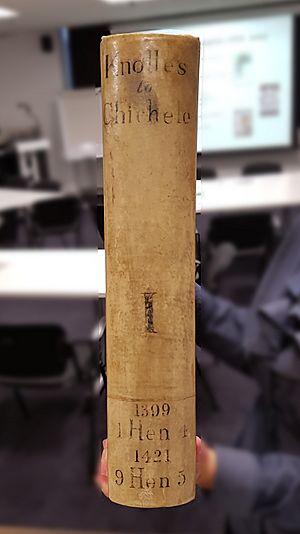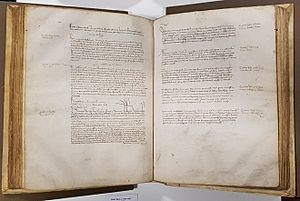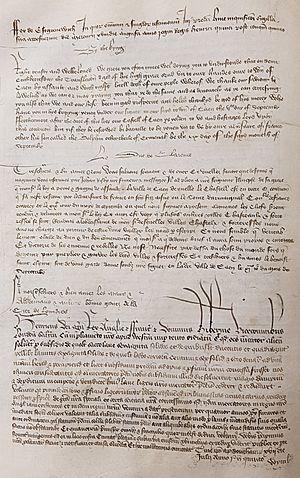Letter-Books of the City of London facts for kids
The Letter-Books of the City of London are a special collection of fifty large books. They were written on vellum, which is a type of treated animal skin used for writing. These books contain important records about the City of London from 1275 to 1509. Today, you can find them at the London Metropolitan Archives, which keeps many historical records for the City of London.
These books got their name because they were labeled with letters from A to Z. After Z, they continued with AA to ZZ. Some early books also had other names. For example, Letter-Book A was called the "Lesser Black Book." Letter-Book B was simply the "Black Book." Letter-Book C was the "Greater Black Book." Letter-Book D was the "Red Book," and Letter-Book E was known as the "White Book." These names often came from the book's size or the color of its cover.
Contents
What's Inside the Letter-Books?
The Letter-Books were written by many different people over time. They don't always follow a perfect timeline. This is because clerks often kept rough notes for a while. Then, they would add these notes to the books later, not always in exact date order. Sometimes, different clerks even wrote in the same book at the same time. This means the information might jump around a bit.
These books tell us a lot about how the City of London worked during the time of the Plantagenets. They contain records written in English, French, and Latin.
Early Records and Important Meetings
The older Letter-Books are very important. They hold the main records of meetings for the Court of Common Council and the Court of Aldermen. These were important groups that helped run the city. Later, these meetings were recorded in separate books called Journals and Repertories.
The final Letter-Books in the series mostly deal with matters about orphans. This shows how the city looked after children who had lost their parents.
Trade and Daily Life
Letter-Books A and B mainly record "recognizances of debts." This means they show agreements where people promised to pay back money. These records are useful for understanding trade between London citizens and places like Gascony and Spain. They show how people traded goods like wine and leather. The books even list the names of people who were licensed brokers for these goods.
Another key part of these books is the "Assize of Bread." This was a set of rules made by the city leaders. It controlled the price and quality of bread. Even these records were sometimes kept out of order.
Important people like Andrew Horn and John Carpenter used these early records. They were both important officials in the City of London. They used the Letter-Books to create their own collections of city rules and customs. Later, historians like Robert Fabyan and John Stow also used these books to write about London's past.
Keeping the Books Safe
We don't know exactly how these important city records were kept safe a long time ago. But like other old city books, the Letter-Books sometimes faced problems.
For example, on the first blank page of Letter-Book E, there's a note from the 1500s. It says that this book was lost for a long time! On July 8, 1540, a city official named Robert Broke found it. He paid 20 shillings (a good amount of money back then) to get it back for the City of London.
It's not clear how the book went missing or for how long. But it's not too surprising that a book could get lost. Strict rules for how the city's records were written and kept weren't put in place until 1537.
All the information from the Letter-Books was later published. This happened between 1899 and 1912. The new collection was called the Calendar of letter-books of the city of London.




